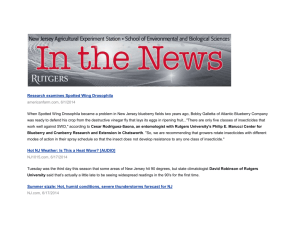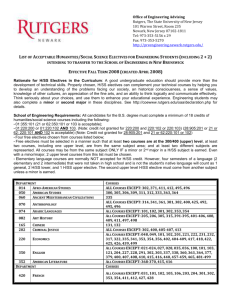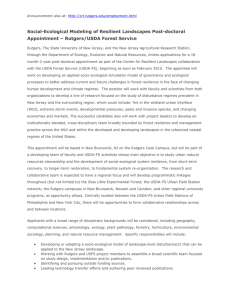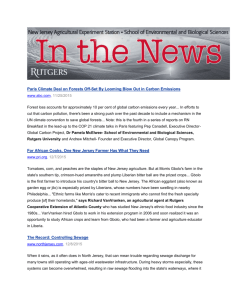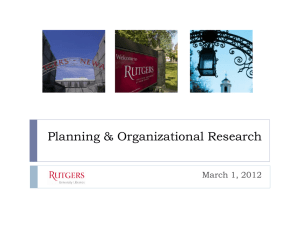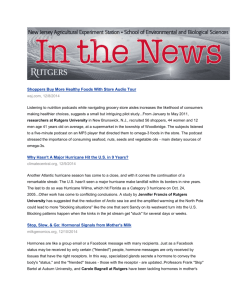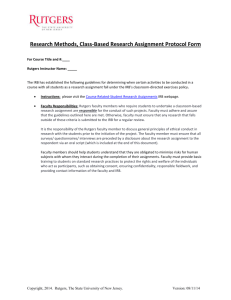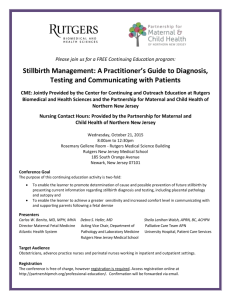Vote Near on Lifting Ban on Oyster Beds in N.J. Waters www
advertisement
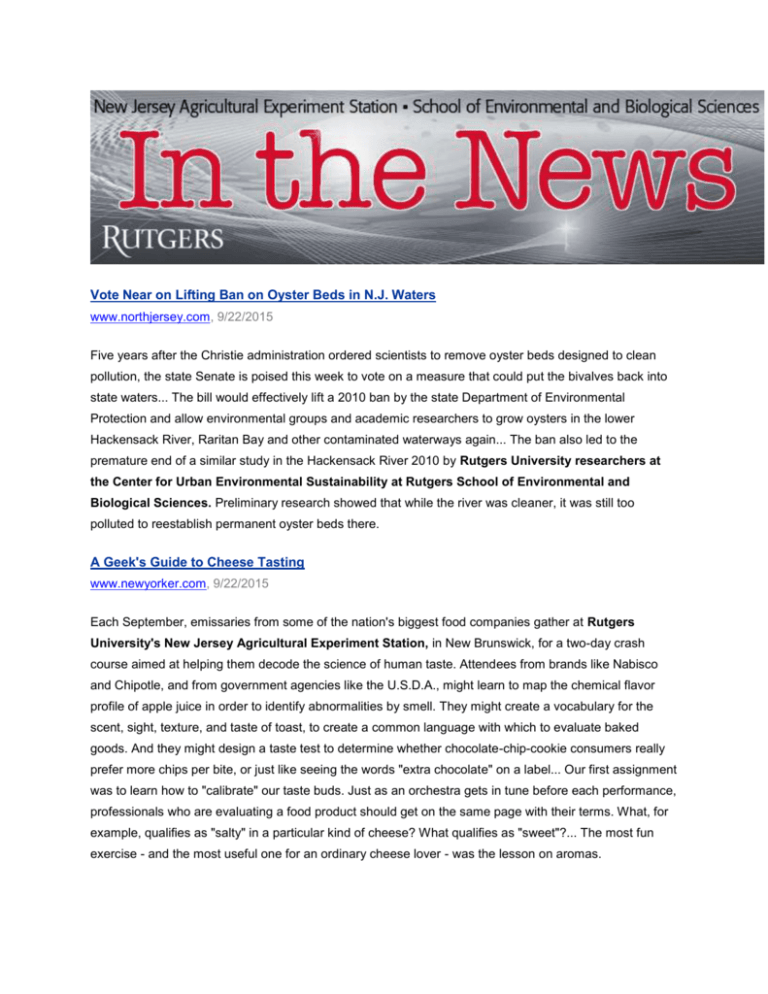
Vote Near on Lifting Ban on Oyster Beds in N.J. Waters www.northjersey.com, 9/22/2015 Five years after the Christie administration ordered scientists to remove oyster beds designed to clean pollution, the state Senate is poised this week to vote on a measure that could put the bivalves back into state waters... The bill would effectively lift a 2010 ban by the state Department of Environmental Protection and allow environmental groups and academic researchers to grow oysters in the lower Hackensack River, Raritan Bay and other contaminated waterways again... The ban also led to the premature end of a similar study in the Hackensack River 2010 by Rutgers University researchers at the Center for Urban Environmental Sustainability at Rutgers School of Environmental and Biological Sciences. Preliminary research showed that while the river was cleaner, it was still too polluted to reestablish permanent oyster beds there. A Geek's Guide to Cheese Tasting www.newyorker.com, 9/22/2015 Each September, emissaries from some of the nation's biggest food companies gather at Rutgers University's New Jersey Agricultural Experiment Station, in New Brunswick, for a two-day crash course aimed at helping them decode the science of human taste. Attendees from brands like Nabisco and Chipotle, and from government agencies like the U.S.D.A., might learn to map the chemical flavor profile of apple juice in order to identify abnormalities by smell. They might create a vocabulary for the scent, sight, texture, and taste of toast, to create a common language with which to evaluate baked goods. And they might design a taste test to determine whether chocolate-chip-cookie consumers really prefer more chips per bite, or just like seeing the words "extra chocolate" on a label... Our first assignment was to learn how to "calibrate" our taste buds. Just as an orchestra gets in tune before each performance, professionals who are evaluating a food product should get on the same page with their terms. What, for example, qualifies as "salty" in a particular kind of cheese? What qualifies as "sweet"?... The most fun exercise - and the most useful one for an ordinary cheese lover - was the lesson on aromas. The Bitter Truth www.gastropod.com, 9/23/2015 This article features the work of Paul Breslin, a member of the Monell Chemical Senses Center as well as a professor in the Department of Nutritional Sciences at Rutgers University. He is a geneticist and biologist whose work focuses on taste perception... The prevailing evolutionary explanation for the ability to taste bitter is that it is a warning signal for toxins - a prompt to our foraging ancestors to spit out the offending leaf or fruit immediately. But, as it turns out, bitter-tasting compounds not only add a delicious complexity to some of our favorite foods and drinks - chocolate, coffee, and beer, to name just a few - but are often quite good for us... Bitter fruits and vegetables already make up less than five percent of the average American's daily diet. Now, as our produce becomes sweeter, bitter-tasting foods have become almost an endangered species. Summer 2015: Not One For the Record Books www.nj1015.com, 9/23/2015 State Climatologist Dave Robinson of Rutgers University says the Garden State's summer climate lacked any excessive heat or cold, and was on the mild side... "It was a summer with quite a mixed bag of conditions, with the exception of the weekends, which were almost exclusively beautiful," Robinson said... Robinson says every weekend day was rain-free, from the beginning of July through Labor Day. He said New Jersey did not have an exceptionally warm summer, just as the past two years have not been exceptionally warm in the eastern U.S., when other parts of the world are experiencing intense heat... In fact, global climate watchers are saying 2015 is on track to go into the books as the warmest year on record for the planet earth. But not so here in the Garden State. According to Robinson, we were above average temperature-wise, in every month of the summer, but not excessively so. Drought Watch Issued In NJ www.app.com, 9/23/2015 With New Jersey's dry spell growing, state officials issued a drought watch Wednesday and called on residents to conserve water... "It is prudent," said David A. Robinson, the New Jersey state climatologist. "I think the timing is right. It's always a tricky call because these generally are somewhat subjective decisions, mind you underlaid by factual data."... If it remains warm and dry and water use does not drop, the state Department of Environmental Protection will consider taking further action, such as declaring a drought warning. Under a warning, the DEP may order water purveyors to develop alternative sources of water or transfer water from areas with relatively more water to those with less, according to the DEP statement... Robinson, the state climatologist who is based at Rutgers University, said rainfall over the past 30 days has been 25 to 50 percent of average. Rainfall in the past 90 days has been about half the norm, and the past 90 days were warmer than normal. BioBlitz: A Snapshot of Sandy Hook's Ecological Diversity www.gmnews.com, 9/24/2015 Summer may be over, but the Sandy Hook peninsula's early days of the offseason have been anything but uneventful... On Sept. 18, the National Park Service (NPS) and the American Littoral Society (ALS) welcomed scientists, naturalists and volunteers of all ages to document species living across Sandy Hook, while engaging in free educational activities like sunset seining in Horseshoe Cove or a nature walk through the holly forest... In 2011, volunteers discovered a total of 433 species, including 155 terrestrial plants and 104 birds. Examining the final results from this year with the 2011 findings could help scientists consider the potential impacts of superstorm Sandy and climate change on the ecology of Sandy Hook... Tom Grothues, assistant research professor at Rutgers University's Department of Marine and Coastal Sciences, said protecting the ecology of Sandy Hook as important for humans as it is for the species that actually live there. Rutgers Expert Offers 'CPR' Tips For Brown Lawns www.gmnews.com, 9/24/2015 The grass is not always greener on the other side. The lack of rainfall and high temperatures this summer have taken a toll on lawns across the state, according to Bill Hlubik, professor and agricultural and resource management agent for the Rutgers Cooperative Extension of Middlesex County's New Jersey Agricultural Experiment Station... Hlubik said most lawn grasses in New Jersey and the Northeast are pure stands or mixtures of bluegrass, fescues and perennial rye grasses, which are cool season turf grasses that go into dormancy when it gets hot and dry. While in dormancy, the grass will slow down its metabolic processes and conserve energy until better conditions return... "Some lawns will revive once adequate rainfall and cooler temperatures return. However, for lawns that were previously struggling, the current drought and heat may be the final smack-down to take weak lawns out of contention for the 2016 season," he said... Throughout September, Hlubik recommended de-thatching lawns. Excess thatch is the dead and brown layer of rhizomes and old roots and plant tissue between the crown or base of the lawn plant and the roots, he said. Antibacterial Soap Has Poor Killing Power www.scientificamerica.com, 9/24/2015 Washing your hands with antibacterial soap containing triclosan - the most common microbe-killing ingredient used in these soaps - may be no better than ordinary plain soap, according to South Korean researchers. The work adds weight to previous studies which have reached similar conclusions and could help settle the controversy of triclosan use... But not everyone agrees. Don Schaffner at Rutgers University who has conducted meta-analyses and risk modelling studies of triclosan says 'this work adds minimally to the debate over the use of triclosan in consumer soaps'. He argues his work points to a clear benefit of triclosan... Schaffner thinks the present results are limited because of the very fact the team used only one variable: soap with or without triclosan. 'While this might seem to be a good idea from the science perspective, it turns out that soap formulation is a tricky business,' he explains. 'For antimicrobials to be optimally effective, the formulation might need to be adjusted. I remain convinced that properly formulated antimicrobial soaps have a benefit over bland, non-antimicrobial soaps.' Super Catnip Repels Mosquitos and Drives Cats Wild www.patch.com, 9/25/2015 A bigger more hearty catnip plant - whose enriched oil not only promises to drive cats crazy with pleasure but also may be a safer, more effective mosquito repellent - has been developed for specialized commercial farmers by Rutgers University... The Rutgers New Jersey Agricultural Experiment Station (NJAES), which has spent more than a decade developing the new breed, CR9, for the insect repellant and pet toy industries recently licensed the product to Ball Horticulture, an Illinois company that will produce the seeds for commercial farmers... "In the past catnip wasn't grown much because the plant itself was never developed to generate commercially acceptable yields from its leaves and flowers which produce its aromatic volatiles oils, and thus, wasn't profitable," said James Simon, professor in the Department of Plant Biology and Pathology at the Rutgers School of Environment and Biological Sciences who led the plant breeding in the development of the new catnip variety. "We developed a super catnip that can survive northern winters and produce copious amounts of aromatic oil with a special composition that is rich in the bioactive compound that repels the mosquitos away and drives cats wild." From the Ground Up: A Bigger, Heartier Catnip Plant www.northjersey.com, 9/26/2015 A bigger, heartier catnip plant - whose enriched oil may be more potent for felines and an alternative mosquito repellent - has been developed for specialized commercial farmers by Rutgers University... The Rutgers New Jersey Agricultural Experiment Station (NJAES), which has spent more than a decade developing the new breed, CR9, recently licensed the product to Ball Horticulture, an Illinois company that will produce the seeds for commercial farmers... "In the past catnip wasn't grown much because the plant itself was never developed to generate commercially acceptable yields from its leaves and flowers, which produce its aromatic volatile oils, and thus wasn't profitable," James Simon, professor in the Department of Plant Biology and Pathology at the Rutgers School of Environment and Biological Sciences, said in a statement. Simon led the plant breeding in the development of the new catnip variety... The NJAES expects to release a line of smaller catnip plants, also with unique essential oils, for home gardeners. The new breed of catnip should be available as seed by 2017. Central Park Horse Show Is An Exciting Challenge www.nj.com, 9/27/2015 A symposium on legal, business and insurance issues impacting the equine industry is being presented Oct. 12 by the Equine Science Center at Rutgers University. The program, featuring experts from all three fields, will be held at the Palace at Somerset Park in Somerset. Topics to be covered include immigration law, worker's compensation for equine operations and insurance coverage, as well as an exploration of the state's "Right to Farm Act" in order for the equine industry to succeed, people in the horse industry have to run their business as a business, said attorney Liz Durkin, vice-chair of the Rutgers University Board of Equine Advancement... "The event organizers felt that it was important to host a seminar, for a nominal fee, that will address the basics of the legal, accounting, and insurance topics for equine operators. Our goal is to assist equine operators in becoming as successful as possible." Israeli Agritech Prowess to Help New Jersey Produce Healthier Food www.timesofisrael.com, 9/27/2015 A new agreement on the development of healthy food products between Israel's Tel-Hai College and New Jersey's Rutgers University brings together two groups that together, leaders of the institutions believe, will be able to greatly advance the cause of healthy foods... A cooperation deal between Rutgers, Tel-Hai, and the State of New Jersey to form the New Jersey-Israel Healthy, Functional, and Medical Foods Alliance was signed earlier in September at a ceremony on the campus of the Rutgers Food Innovation Center, an incubator/accelerator that works with start-ups developing technology for healthier prepared foods... New Jersey, meanwhile, is a leader in processed food production. While the Garden State is perceived as an urban center (due to its proximity to both New York City and Philadelphia), it is actually a leading state in terms of agricultural income per acre, and one of the top states for processed food manufacturing. The Rutgers Food Innovation Center seeks to leverage these capabilities in order to support and expand the state's food industry. Study: Sea Level Rise Increasing Major Storms off New Jersey www.seattletimes.com, 9/28/2015 A new study looking back over 1,000 years finds the flooding risk along the New York and New Jersey coasts increased greatly after industrialization, and major storms that once might have occurred every 500 years could soon happen every 25 years or so... The study by Penn State, Rutgers, Princeton, and Tufts universities, and Massachusetts Institute of Technology, finds that flood heights have risen nearly 4 feet since the year 850, largely because of a sea level rise. The study advocates better risk management strategies to cope with storms... "A storm that occurred once in seven generations is now occurring twice in a generation," said Benjamin Horton of Rutgers, one of six lead researchers involved in the study. "What we do know is that as sea level rise accelerates into the future, we are going to have more frequent flooding."... "Every inch deeper in a core takes you further back in time," Horton said. "We can stretch this technique back hundreds of years and thousands of years." Study: Sea Level Rise Increasing Major Storms Off New Jersey www.nytimes.com, 9/28/2015 Major storms that once might have hit the coasts of New York and New Jersey every 500 years could soon happen every 25 years or so... The study by Penn State, Rutgers, Princeton and Tufts universities and the Massachusetts Institute of Technology finds that flood heights have risen nearly 4 feet from the year 850, largely because of the sea level rise... Researchers advocate better risk management strategies to cope with future storms... It was released a month before the third anniversary of Superstorm Sandy, which devastated coastal New York and New Jersey. 500-Year Storms Could Now Occur Every 24 Years, Study Says www.nj.com, 9/28/2015 Under normal odds, the chance that a New York City or Jersey Shore resident would witness a so-called "500-year flood" - one with massive storm surge and flooding - would be so low, many residents would never live to witness one... "A storm that occurred once in seven generations is now occurring twice in a generation," said Benjamin Horton, a Rutgers University marine and coastal sciences professor... According to Horton and researchers from the Massachusetts Institute of Technology and Princeton, Tufts and Penn State universities, rising sea levels and increases in the types of storms that produce the largest storm surge are behind the rising threat... To look further into the past, the researchers studied salt marshes near New York City and along the Jersey shore. They took ground core samples, looking for microfossils called foraminifera. According to Horton, some species of foraminifera are linked to salt marsh growth and, therefore, high ocean levels. Others do not thrive in salt water, and would indicate fresh water and lower ocean levels. Garden State Is Wasting Its Waste, Should Better Utilize Biomass, Report Says www.njspotlight.com, 9/28/2015 More than 4 million tons of New Jersey's biomass -- fuel derived from organic materials like plants and waste -- could be used to produce electricity or propel transportation each year... The bulk of the biomass (72 percent) is produced directly by the state's population, typically in the form of municipal garbage, according to an assessment by Rutgers University's New Jersey Agricultural Experiment Station... The resource, largely underutilized, could help the state achieve important policy goals, including reducing dependence on fossil fuels, improving air quality by eliminating harmful pollution from fossil fuels, and curbing greenhouse-gas emissions that contribute to global climate change... Besides municipal solid waste, the potential biomass resources include a range of materials and waste products: landfill gas, agricultural and forest residues, wastewater sludge, manure, and food waste. We invite you to send an email to InTheNews@aesop.rutgers.edu alerting us when you are quoted in a story or if your program is mentioned in the news. Please send links of news, as it happens, as some media outlets do not retain online links beyond a week. Visit the SEBS and NJAES Newsroom at sebsnjaesnews.rutgers.edu.

